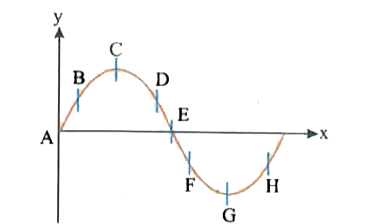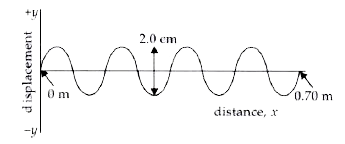A series of pulses, each of amplitude 0.150m, are sent on a string that is attached to a wall at one end. The pulses are reflected at the wall and travel back along the string without loss of amplitude. When two waves are present on the same string. The net displacement of a given point is the sum of the displacement of the individuals waves at the point. What is the net displacement at point on the spring where two pulses am crossing, (a) if the string is rigidly attached to the post? (b) if the end at which reflection occurs is free is slide up and down ?
The correct Answer is:(a) Zero , (b) 0.300m.
Step by step video, text & image solution for A series of pulses, each of amplitude 0.150 m, are sent on a string that is attached to a wall at one end. The pulses are reflected at the wall and travel back along the string without loss of amplitude. When two waves are present on the same string. The net displacement of a given point is the sum of the displacement of the individuals waves at the point. What is the net displacement at point on the spring where two pulses am crossing, (a) if the string is rigidly attached to the post? (b) if the end at which reflection occurs is free is slide up and down ? by Physics experts to help you in doubts & scoring excellent marks in Class 12 exams.
Updated on:21/07/2023Topper's Solved these Questions
- WAVE ON STRING BOOK - RESONANCECHAPTER - WAVE ON STRING EXERCISE - Exercise- 1 PART II
31 Videos
- WAVE ON STRING BOOK - RESONANCECHAPTER - WAVE ON STRING EXERCISE - Exercise- 2 PART I
21 Videos
- WAVE ON STRING BOOK - RESONANCECHAPTER - WAVE ON STRING EXERCISE - Board Level Exercise
27 Videos
- TRAVELLING WAVESBOOK - RESONANCECHAPTER - TRAVELLING WAVESEXERCISE - Exercise- 3 PART II
7 Videos
- WAVE OPTICSBOOK - RESONANCECHAPTER - WAVE OPTICSEXERCISE - Advanced Level Problems
8 Videos
Similar Questions
A wave pulse on a string moves a distance of 8 min 0.05 s.
Find the velocity of the pulse.
View SolutionA transverse wave is travelling along a horizontal string. The first figure is the shape of the string at an instant of time. The second picture is a graph of the vertical displacement of a point on the string as a function of time. How far does this wave travel along the string in one second?
 ,
,
View Solution
Knowledge Check
Assertion: Standing waves are formed when amplitudes of two constituent waves are equal.
Reason: At any point net displacement at a given time is resultant of displacement of constituent waves.AIf both Assertion and Reason are true and the Reason is correct explanation of the Assertion.BIf both Assertion and Reason are true but Reason is not the correct explanation of Assertion.CIf Assertion is true, but the Reason is false.DIf Assertion is false but the Reason is true.A sinusoidal transverse wave is traveling on a string. Any point on the string
Amoves in the same direction as the wave.Bmoves in simple harmonic motion with a different frequency than that of the wave.Cmoves in simple harmonic motion with the same angular frequency as the waveDmoves in uniform circular motion with a different angular speed than the wave.A transverse wave is travelling along a string from left to right. The figure below represents the shape of the string at a given instant. At this instant the points have an upward velocity are (here X-wave displacement, Y- particle displacement)
 AD,E,FBA,B,HCB,D,FDA,E,H
AD,E,FBA,B,HCB,D,FDA,E,H
A harmonic source (S) is driving a taut string. The other end of the string is tied to a wall that is not so rigid. It is observed that standing waves are formed in the string with ratio of amplitudes at the antinodes to that at the nodes equal to 8. What percentage of wave energy is transmitted to the wall?

View SolutionA snapshot is taken of a periodic wave travelling on a string as shown below. What is the amplitude and wavelength of the wave?

View SolutionConsider two waves passing through the same string. Principle of superposition for displacement says that the net displacement of a particle on the string is sum of the displacements produced by the two waves individually. Suppose we state similar principles for the net velocity of the particle and the net kinetic energy of the particle. Such a principle willl be valid for
View SolutionA wave pulse on a string moves a distance of 8 min 0.05 s.
What would be the wavelength of the wave on the same string if its frequency is 200 Hz?
View SolutionA pulse on the string is inverted when it is reflected from
View Solution